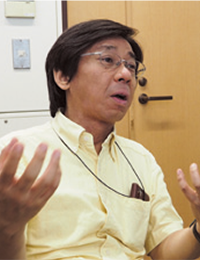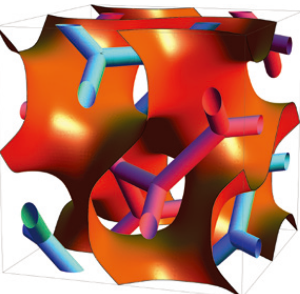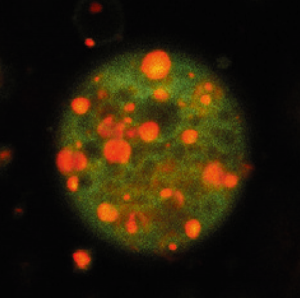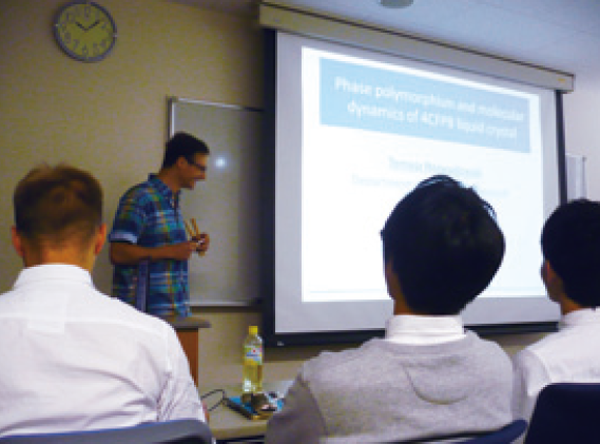キーワード: ソフトマター、複雑液体、液晶、バイオマテリアル
http://www.chem.tsukuba.ac.jp/sms/
 ソフトマターとは、液晶・高分子など柔らかい物質の総称で、物理学・化学・生物学の境界領域に位置し、多角的な視点から研究が発展します。そこで、液晶、複雑液体、バイオマテリアルを3本の柱に、理論と実験を有機的に結合した主担当グループを組織し、研究を強力に推進するリサーチユニット「ソフトマター科学」を結成しました。
ソフトマターとは、液晶・高分子など柔らかい物質の総称で、物理学・化学・生物学の境界領域に位置し、多角的な視点から研究が発展します。そこで、液晶、複雑液体、バイオマテリアルを3本の柱に、理論と実験を有機的に結合した主担当グループを組織し、研究を強力に推進するリサーチユニット「ソフトマター科学」を結成しました。
ソフトマターの可能性は無限大

図1:ソフトマターで広く見られる双連結構造の単位格子。赤と青のギャングルジムが周期的極小曲面で仕切られた二つの空間に存在する。液晶では1000 個ほどの分子が集まってこのような構造を作る。
“物のありよう”の研究(物性物理学)ははじめ、金属、半導体、セラミックなどの硬いもの(ハードマター)対象に急速に発展しました。ハードマターは大多数の原子が規則正しく配列している結晶構造を持ち、測定することも理論的研究も比較的容易で、様々なモノに実用されてきました。一方、ソフトマターは、生物の体、食べ物、数々の石油化学製品など、私たちの身の回りにあふれているものです。意外なことですが、ガラスのように“硬い”物質の中にもソフトマターに分類されるものがあります。ガラスの中は実は原子がバラバラに配列していて、「粘り気が極度に高い液体」の状態なのです。結晶のようにがっちり原子配意が固定されておらず様々に変化できる「液晶」もソフトマターの代表格です。
「ソフトマター」という言葉は、ピエール=ジル・ド・ジェンヌがこの分野の研究でノーベル物理学賞を受賞した1991年頃から使われ始め、近年では生体膜や化粧品などへの応用研究が注目されています。ソフトマターは分子の集まり具合で形や性質が決まり、また、光や温度で変形するなど多様な性質を持ちます。混沌の中の可能性を探るのがソフトマター研究の醍醐味です。

図2:細胞膜類似の構造をもつベシクル(閉じた小胞)上の脂質二重膜内で起きた相分離(蛍光色素でオレンジとグリーンに着色)。機能発現にはこうした膜の不均一が重要と考えられている。
齋藤教授の研究グループはリサーチユニット発足後の2012年、液晶を対象に行った研究から、複雑な構造における分子の凝集構造を明らかにしました。この構造(図1)は高分子でも広く見出されることから、「科学新聞(2012年9月7日付)」でも『ジャイロイド相の分子配列解明』と紹介されるなど注目を集めました。
リサーチユニットメンバーの現在の研究対象は、ガラスを含む複雑液体、液晶、生体関連物質が主で代表的なソフトマターである高分子が手薄ですが、液晶研究のアイデアを生体物質に適用するなどして研究の展開を図っています。
つくばエリアのソフトマター研究を結集
ソフトマター研究はまだ開拓時代ですから、異分野の研究者が刺激しあいながら難解な敵に挑む体制が有効です。幸い、つくばエリアには筑波大学に加えて、産総研、NIMS、KEKといった研究機関がソフトマター研究者を有し、ごく自然に少人数での研究集会を行っていました。その活動が発展し、つくばエクスプレス沿線の東大物性研究所も加わって、「つくばソフトマター研究会」と題して研究発表会を年1回開催(2009年~)するほか、学生を介した相互協力や共同プロジェクトでの連携など活動は広がりを見せています。
社会への貢献・実績

図3:クラクフ核物理研究所(ポーランド) から2 名の研究者を招きセミナーを 開催(2014 年11 月)
- 一般向け書籍出版:瀬戸秀紀 (著) 「 ソフトマター
やわらかな物質の物理学」( 米田出版, 2012) - 「 つくばソフトマター研究会2013」開催
( 2013年3月11日 会場:筑波大学) - 国内外の研究者を招き、年2 ~ 3回セミナーを開催
取材:平成27年7月22日
The brains of Tsukuba to take on the challenge of soft matter research
Unit members : Shoji, Mitsuo Nagatomo, Shigenori
Unit name: Soft-Matter Science
Key words: soft matter, complex liquid, liquid crystal, and biomaterial
 Soft matter – a collective term for soft substances, is positioned on the borders between physics, chemistry, and biology, and the development of its research is facilitated by multifaceted perspectives. Researchers specializing in the fields of liquid crystals, complex liquid, and biomaterial organized a group, which organically integrates theories with experiments, as the research unit: “Soft-Matter Science”, to actively promote research on soft matter.
Soft matter – a collective term for soft substances, is positioned on the borders between physics, chemistry, and biology, and the development of its research is facilitated by multifaceted perspectives. Researchers specializing in the fields of liquid crystals, complex liquid, and biomaterial organized a group, which organically integrates theories with experiments, as the research unit: “Soft-Matter Science”, to actively promote research on soft matter.
Infinite possibilities of soft matter

Figure 1: Unit lattices in the dual-concatenated structure often identified in soft matters. There are red and blue jungle gym-shaped structures in two spaces separated by a periodic minimum surface. Liquid crystals have such a structure consisting of approximately 1,000 molecules.
When research on “physical properties” (condensed matter physics) initially evolved at a significant rate, its subjects were primarily metals, semiconductors, ceramics, and other hard matter. The crystal structure of hard matter is characterized by the orderly arrangement of the majority of its atoms. Since it is relatively easy to measure hard matter and/or conduct their theoretical studies, they have been used to create various products and materials. On the other hand, soft matter, such as the bodies of organisms, food, and a variety of petrochemical products, are easily available to us. Some “hard” substances like glass are classified as soft matter, to our surprise. Glass is actually “a fluid substance with a markedly high viscosity”, and its atoms are irregularly arrayed. “Liquid crystals”, which can change into various forms because the arrangement of its atoms is irregular unlike crystals, also represent soft matter.
People started to use the term “soft matter” around 1991, when Pierre-Gilles de Gennes received a Nobel Prize in Physics for his research achievements in this field. In recent years, research on their applications to biomembranes and cosmetics has received attention. The shape and properties of soft matter are determined by the form of its molecular assembly. Soft matter has many distinctive characteristics: e.g., their forms change when they are subjected to light or temperature changes. The pursuit of possibilities in a chaotic environment motivates researchers on soft matter.

Figure 2: Phase separation (stained in orange and green using fluorescent dyes) identified in lipid bilayer membranes on (closed) vesicles with a structure analogous to cellular membranes. These inhomogeneous membranes are considered to be the key to the expression of cellular functions.
In 2012, following the establishment of the research unit, the research group led by Professor Saito conducted research on liquid crystals, and clarified the complex structure of molecular assembly. Since many different polymers have this structure (Figure 1), the findings attracted much attention, including the publication of a report entitled “Analyses of molecular arrays in the gyroid phase” in the “Science News” (on September 7, 2012).
At present, the subjects of research conducted by the unit members are primarily complex liquids, including glass, liquid crystals, and biologically relevant substances, rather than polymers – a representative soft matter. However, the members have been exerting efforts, including the application of ideas developed for research on liquid crystals to biologically relevant substances to facilitate the development of research.
Assembly of soft matter research activities in the Tsukuba area
As research on soft matter is still at the development stage, a system that encourages researchers from different fields to inspire each other and take on difficult challenges is effective. Fortunately, there are also researchers on soft matter in other research institutions in the Tsukuba area other than the University of Tsukuba, such as the National Institute of Advanced Industrial Science and Technology, NIMS, and KEK, and they have voluntarily held small research meetings. The meetings are developing further into a variety of activities, including an annual workshop (from 2009) referred to as the “Tsukuba Soft Matter Workshop” with researchers of the Institute for Solid State Physics at the University of Tokyo, located along the Tsukuba Express line, and cooperative and collaborative projects involving students.
Social contributions and achievements

Figure 3: Held a seminar (in November 2014) inviting two researchers from the Institute of Nuclear Physics in Cracow (Poland)
– Publication of books for the general public: “Soft Matter Physics” written by Hideki Seto (Yoneda Shuppan, 2012)
– “Tsukuba Soft Matter Workshop 2013” held on March 11, 2013, at the University of Tsukuba
– Held seminars two to three times a year inviting researchers from across Japan and other countries
Interviewed on July 22, 2015
